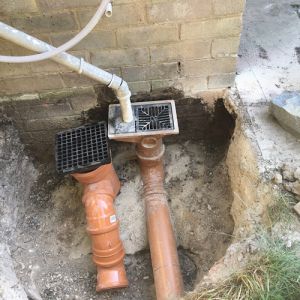Placement of Samsung R290 ASHP
Posted by: @jancold@jamespa I notice they talk of untrapped drain or cellar entry. I'm pretty sure my rainwater drains connect to the main sewer so surely they must have a trap? So they should not be a problem?
To be honest I hadn't noticed this subtlety. Drains connected to sewers should have a trap, mine certainly do.
4kW peak of solar PV since 2011; EV and a 1930s house which has been partially renovated to improve its efficiency. 7kW Vaillant heat pump.
I wanted to put our r290 gshp near a kitchen drain. And found to my dismay that it didn’t have a trap! Bit of a faff, but managed to swap it out for one with a bottle trap (in piccy left is new bottle trap, right one is direct to sewer). Didn’t particularly smell, weird.
Wandering around the internet I find there are ice making machines with R290 that are allowed to be inside buildings albeit with only 150 gm of charge.
Daikin 6Kw ASHP.
MG4 EV
1926 Semi with loft and wall cavity insulation, all radiator.
I also came across this showing the result of a "perfect" gas mix explosion on a yacht. Of interest is the first failed ignition showing how the explosive mix ( 2 to 10%) had not been achieved.
A heat pump is outside in free air so a leak would normally disperse, however I agree it's not worth the risk.
In an earlier life I was a Deck officer with Shell. They had two VLCC's (Very large crude carriers) returning from the Gulf and cleaning tanks with high pressure hot water. An explosive mix built up and an electrostatic spark set it off. One sank and the other had to be scrapped. Thereafter the tanks were always kept filled with inert gas from the boiler! This was just before I started my training with Shell and I did not hear about it until some time afterwards!
Maybe I'll go with R32. 😀
Daikin 6Kw ASHP.
MG4 EV
1926 Semi with loft and wall cavity insulation, all radiator.
Daikin 6Kw ASHP.
MG4 EV
1926 Semi with loft and wall cavity insulation, all radiator.
Compared to having ‘natural’ gas piped continuously into a home -a permanent gas source, the tiny amount of r290 kept safely in a heatpump for many many years seems benign. If indeed it did leak out fast enough in a small enough enclosure to achieve an explosive mixture, you’d have a limited time window to apply a spark before it all leaked out into atmosphere anyway.
@jancold I think that that is the argument; the gas may disperse into the drain - hence to the sewers. As mentioned though, the quantities are very small compared with say a BBQ propane or butane tank. Regards, Toodles.
Toodles, heats his home with cold draughts and cooks food with magnets.
Also, as indicated in the video up-thread, worse things happen at sea
Toodles, heats his home with cold draughts and cooks food with magnets.
Posted by: @roblCompared to having ‘natural’ gas piped continuously into a home -a permanent gas source, the tiny amount of r290 kept safely in a heatpump for many many years seems benign. If indeed it did leak out fast enough in a small enough enclosure to achieve an explosive mixture, you’d have a limited time window to apply a spark before it all leaked out into atmosphere anyway.
In general I would agree, but there are a few specifics to bear in mind, some obvious, some less so.
Firstly, propane is denser than air and so, in an enclosed space, will pool. Outside or in a room with good airflow it will indeed dissipate but obviously not in a sewer or septic tank.
Secondly, propane is pretty stable so won't break down over time. Any propane released into the outside atmosphere will still remain propane until burned (even if the concentrations when that happens will mean its effects are undiscernable). What that means is that if any propane did escape from a heat pump into a sewer and pool there it would remain as a pocket of propane that could be added to at a later date by the escape of more propane from another heat pump/ice machine/leaky gas bottle etc. Just because one device contains very little doesn't necessarily mean you can ignore cumulative effects.
Thirdly, the time window is a bit of a weird one. I remember way back when I was at school a demonstration whereby two holes were made in a catering-sized instant coffee tin; one in the base, one in the lid. A gas pipe was removed from a bunsen burner and put into the bottom hole, and the tin was filled with gas. Once full, the gas escaping from the top was lit and, of course, burned just as one would expect - in effect, the tin had just become an extension to the tube. The gas was then turned off and the tube immediately removed from the bottom, and the flame at the top of the tin steadily worked its way back into the tin as the gas was used up, being replaced by air from the outside. At the point the gas concentration got low enough to form the perfect ratio the remaining gas reacted all at once and the explosion blew the lid off the tin. I'm sure you could find plenty of videos of this demonstration on Youtube. The point, though, is that if your escaped propane pools in an enclosed space it doesn't need to be ignited quickly or even when the gas/air ratio is exactly right; all it needs is to be ignited when there's more than enough propane to burn and then chemistry will do the rest with an explosion following shortly afterwards.
I should point out that I'm not trying to teach good ol' Granny to suck eggs; I'm guessing you already know these details. All I'm trying to do is give a bit of context to the reasoning behind the regulations for anyone who isn't already aware. And with that context in mind, it becomes clearer not just why treating a heat pump like a 47kg propane bottle is inappropriate but also why the propane in a heat pump shouldn't be ignored completely.
105 m2 bungalow in South East England
Mitsubishi Ecodan 8.5 kW air source heat pump
18 x 360W solar panels
1 x 6 kW GroWatt battery and SPH5000 inverter
1 x Myenergi Zappi
1 x VW ID3
Raised beds for home-grown veg and chickens for eggs
"Semper in excretia; sumus solum profundum variat"
The choice of refrigerant is always a compromise. So far as I'm aware, they are generally:
Poisonous / High GWP / ozone depleting / flammable / super high pressure
I don't think there is an obvious "perfect" refrigerant - ie. one with no compromises. Propane used to be the refrigerant of choice some 100 years ago, then we had ozone depleting ones, then high GWP ones; now back to propane. I appreciate there's always new ones out like R1234yf (Tetrafluoropropene) - maybe that has no downsides?.
Posted by: @roblI appreciate there's always new ones out like R1234yf (Tetrafluoropropene) - maybe that has no downsides?
Sadly a very significant downside, turned out the 'too good to be true' HFO synthetic refrigerants like R1234yf and R1234ze were, well, too good to be true. They contain PFAS compounds, so-called 'forever synthetic chemicals' which don't break down in the environment. There is planned legislation in the EU to ban PFAS substances, which, if adopted, will kill off the tranche of popular HFO refrigerants such as those above and many of the R45* numbered HFO commercial products.
R290 propane is the refrigerant which the domestic ASHP heat pump industry will adopt. Ideal (part of Groupe Atlantic) has just launched their R290 ASHP models only a year after launching their R32 model range. In hindsight, they didn't quite anticipate or consider the EU legislating so quickly to further drawn down on higher GWP refrigerants such as R32. Grant has R290 models planned for launch later this year and currently on trial - Chinese made & badged up sadly, so not made locally.
Some of the restrictions on locating R290 ASHPs are a little over-cautious, and not based on an accurate risk assessment of the unit charge, probable leakage rate & explosion potential. Hopefully some common sense will prevail in due course.
- 26 Forums
- 2,396 Topics
- 54.3 K Posts
- 209 Online
- 6,077 Members
Join Us!
Worth Watching
Latest Posts
-

RE: Setback savings - fact or fiction?
No need to create a new thread, @sheriff-fatman. You do...
By Majordennisbloodnok , 6 hours ago
-

RE: Power outages and storms: A surprisingly good DNO experience
Well done to Scottish Power for doing a good job. Well ...
By Majordennisbloodnok , 6 hours ago
-
RE: Advice for a novice on Mitsubishi Ecodan 6kW
Fair point. The highest frequency of defrosts I'd seen...
By Sheriff Fatman , 7 hours ago
-

RE: Heatpunk Floor plan issues
It's usually the complete opposite... seldom that Safar...
By Mars , 7 hours ago
-
RE: RDSAP10 effect on existing heat pump EPC rating?
@mike-patrick interesting update - thanks.I've been thr...
By Tim441 , 8 hours ago
-
RE: Recommended home battery inverters + regulatory matters - help requested
I remember reading in some inverters. They mandate a se...
By Batpred , 9 hours ago
-

RE: Fan is clipping ice build up from the front of unit.
@majordennisbloodnok I’ll not go there thanks! Toodles.
By Toodles , 10 hours ago
-

RE: Running from backup generaor in powercut?
@majordennisbloodnok Back in the 80’ or 90’ we had a te...
By Toodles , 10 hours ago
-
RE: Running my new Nibe ASHP efficiently
I'm new to the forum. Did you get a reply to this last ...
By Mike @ Camelot , 11 hours ago
-

RE: ASHP Energy Consumption: Aira 12kW heat pump
@grantmethestrength MCS requirements for DHW capacity h...
By Toodles , 12 hours ago
-
RE: New Mitsubishi Ecodan 11.2kW installation - L9 errors and maybe more
Great to hear! I just figured this out a day or tw...
By anotherdaveuk , 13 hours ago
-
RE: Help me keep the faith with my air source heat pump installation
@adamk I'm observing my own system at low temperatures ...
By dr_dongle , 18 hours ago
-

RE: Free Ecoheat Heat Pump Install
@deltona Yes older houses are problematic like that, bu...
By bontwoody , 2 days ago
-
RE: Radiator sizing sanity check
As I mentioned early on the cost of supplying and fitti...
By JamesPa , 2 days ago
-
RE: Electricity price predictions
Great point, one of the key ones in my chat with Octopu...
By Batpred , 2 days ago
-

RE: New Fogstar 15.5kWh upright solution
Let me point out that there are many Chinese suppliers ...
By Transparent , 2 days ago
-

RE: Weather compensation- why you should use it
@majordennisbloodnok — The Two Ronnies Mastermind sketc...
By cathodeRay , 2 days ago
-
Just realised that this image of the cylinder cupboard ...
By Sheriff Fatman , 3 days ago
-

RE: Rodents! A word of warning for heat pump owners
Two thoughts: 1: Let's ask @david-s if Primary Pro in...
By Transparent , 3 days ago
-
RE: Solis S6-EH1P8K-L-PLUS – Why I Chose It and What I’ve Learned So Far
In the diagram below, I describe my understanding of th...
By Batpred , 3 days ago







